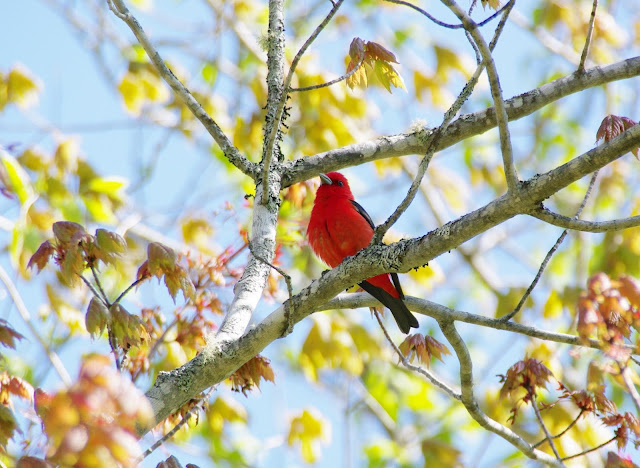We Have Some Very Beautiful Birds!
 |
| Baltimore Oriole |
Florida, California, Texas, move over. We have some very beautiful birds, too. Now that it is summer, we have our full complement of birds here in our province. Well, I have to qualify that, because we do have a few winter residents that have left us for more northerly climes. But our bird population is at its maximum right now. That means lots of species and high numbers. The birds that summer here are in full numbers. The young of the year have left the nest (or soon will) bumping up the population numbers.
Some of our summer residents are overly beautiful. They are all unique and many are beautiful, but some are off the chart. Today I am featuring three such species; the Baltimore Oriole, the Scarlet Tanager and the Indigo Bunting.
Generally speaking, the birds are in their breeding plumage in the spring and towards mid-to-late summer they start to moult. They gradually lose (and replace) their flight and body feathers. Often their second plumage (non-breeding) is less spectacular.
The Baltimore Oriole (see above) arrives in late May and stays with us into the autumn. At that time both the male and female are beautiful but the male is brilliant. His flaming orange, yellow and black colours pattern his body beautifully. It is interesting that his orange is the same colour as a ripe orange fruit and they enjoy treats of oranges put out for them on their arrival. We had them coming regularly to oranges this year. I was amused to see the male come and peck on an orange light bulb of an outdoor light to see if it could be eaten. The orioles feed on fruit and insects and nest in large deciduous trees.
 |
| Scarlet Tanager |
The Scarlet Tanager arrives in mid-to-late May. It prefers to live high up in large deciduous woods. They are not often seen for that reason. However, if we take time to learn their song, we can become more aware of their presence. They sound a lot like a Robin. Some describe their song to be like a Robin with a sore throat. The male tanager is amazingly beautiful. The scarlet red on his body could not be any brighter. When viewed at close range, it looks fluorescent. It is set off beautifully with the black wings. The female is more subdued with yellow and black. Tanagers feed on insects and fruits.
 |
| Indigo Bunting |
The Indigo Bunting arrives about the same time as the orioles and tanagers. They feed on insects, seeds and fruits and are often first seen at feeders. What a delight it is to look at your feeder and see this bird! Its blue is rich and iridescent. The female is a much duller brownish colour. As the spring advances, the buntings move away from feeders and feed near their nesting sights in bushes and thick vegetation.
Summer is the time to enjoy our avian treasures.
Summer is the time to enjoy our avian treasures.
No comments:
Post a Comment